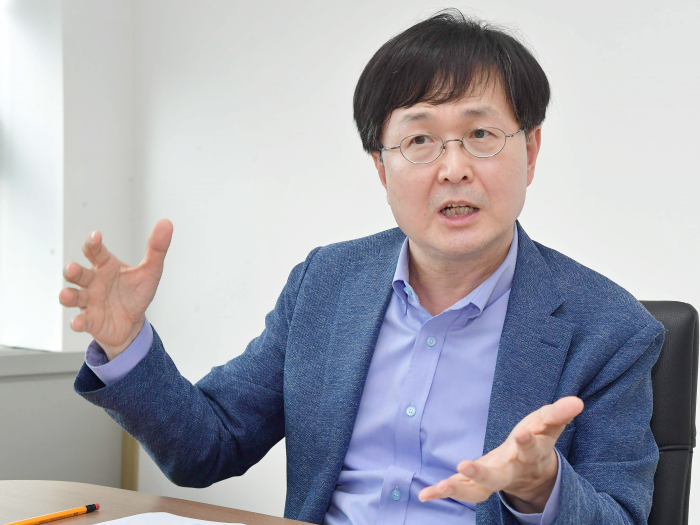Pension funds
Yellow Umbrella sets sights on warehouses, secondaries
The $14 bn savings fund looks at GPs' asset size, experience rather than track record
By Aug 13, 2021 (Gmt+09:00)
3
Min read
Most Read
Samsung shifts to emergency mode with 6-day work week for executives


Alibaba eyes 1st investment in Korean e-commerce platform


Blackstone signs over $1 bn deal with MBK for 1st exit in Korea


NPS loses $1.2 bn in local stocks in Q1 on weak battery shares


OCI to invest up to $1.5 bn in MalaysiaŌĆÖs polysilicon plant



The Yellow Umbrella Mutual Aid Fund, a $14 billion savings arm of South Korean small business owners, is planning to further reduce the proportion of fixed-income securities and instead, will raise exposure to infrastructure assets such as overseas distribution centers, its chief investment officer said on Friday.
The savings fund is also interested in overseas private equity secondary deals. But it shuns away from co-investments with general partners, which did not work well during his four-year tenure at the country's police fund, said Lee Do-yoon who took over as CIO of the Yellow Umbrella Mutual in June of this year.
"Given the prospect of interest rate hikes, it would be difficult to enter the bond market now. Instead, we're keen on alternative investments such as social overhead projects," he told Market Insight in an interview.┬Ā
"In particular, we are keeping a close eye on overseas distribution centers."
It was his first interview with the capital news outlet of The Korea Economic Daily since he was installed as the mutual aid fund's CIO.
Lee, a fixed-income expert, had headed the Police Mutual Aid Association as investment chief between 2016 and late 2020. During his stint at the police fund, he had increased the $3 billion fund's risk spectrum toward distressed and mezzanine assets.
For the Yellow Umbrella, however, he is unwilling to raise risk appetite in the near future.
Unlike the Military Mutual Aid Association and the Police Mutual Aid Fund whose members are also beneficiaries of either the Government Employees Pension Corporation or the National Pension Service (NPS), many of Yellow Umbrella's subscribers do not contribute money to them.
"Thus, Yellow Umbrella Mutual Aid Fund is the last resort for our small business owners. We will increase the proportion of alternative investments with a steady income stream, but not raise our risk appetite."
He expects the US Federal Reserve to begin to taper its asset purchases either from the end of this year, or early next year.
Yellow Umbrella is under the Korea Federation of Small and Medium Business. It manages 16.5 trillion won ($14 billion) in assets, of which fixed income accounts for 55.5%. Alternatives make up 22% and equities 16%.
Since the COVID-19 outbreak, voluntary contributions from its 1.5 million members have been rising sharply. They opted to deposit a bigger amount of money into the savings fund rather than spending on business, after the pandemic forced them to scale back operations.┬Ā
Every month, Yellow Umbrella has received 253.4 billion won ($220 million) in contributions on average since the start of the year, a 35% increase compared to 2018 when 187.2 billion won in contributions was deposited to the fund on a monthly basis. The money voluntarily deposited to the fund is not subject to confiscation when their business goes under.
EYES ON INVESTMENT SIZE, EXPERIENCE OF GPs
This year, Yellow Umbrella posted a 4.2% return on investments as of the end of July, above its annual target of 3.61%. The return was driven mainly by equity investments.
As the fund's new investment chief, Lee said he puts his priority on training its in-house investment managers to improve their deal selection capabilities.
When choosing external managers, he will focus on their asset size and business experience as well as internal systems, rather than track records.
Regarding co-investments with investment companies, he dismissed the possibility, contrary to the NPS and the Public Officials Benefit Association which have been ramping up co-investments with general partners.
"In my experience, co-investments didn't work well practically and we refrain from them. But we're interested in making overseas secondary investments with PEFs."
Write to Jae-hu Kim at hu@hankyung.com
Yeonhee Kim edited this article.
More to Read
-
 [Exclusive] Chief Investment OfficersEx-police fund CIO picked to lead Yellow Umbrella Mutual
[Exclusive] Chief Investment OfficersEx-police fund CIO picked to lead Yellow Umbrella MutualMay 04, 2021 (Gmt+09:00)
1 Min read -
 Korean police fund raises risk appetite for private debt
Korean police fund raises risk appetite for private debtOct 27, 2020 (Gmt+09:00)
6 Min read
Comment 0
LOG IN


